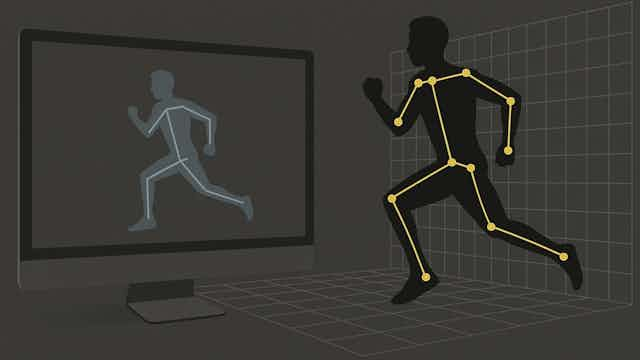In sport, the margin between success and failure is often measured in milliseconds. It could be a cricketer adjusting their foot positioning, a runner refining their sprint start or a footballer perfecting their passing.
This is where motion capture comes in – among the many approaches being used for athletic performance and movement analysis.
Conventional motion capture tracks a person’s movements by using sensors or reflective markers linked to cameras. This provides data that helps sport scientists analyse how to improve an athlete’s performance, personalise their training programme and prevent possible injury.
But for decades, motion capture in sport has been done using cumbersome suits and complex camera systems. These technologies offer high precision, but have remained out of reach for many because of their cost, technical demands and rigid laboratory constraints.
As sport evolves, so too must the technology that analyses it. The way we measure human movement is experiencing a major transformation. Markerless motion capture (enabled by artificial intelligence, computer vision, depth sensors and multiple-camera systems) is set to revolutionise sports performance analysis.
As a health and sports scientist with a focus on data, innovation and technology, I co-authored a study on markerless motion capture in sports and exercise. We reviewed and compared various motion capture options so that users can choose what system is best for their needs and budgets.
This matters because markerless motion capture provides a practical alternative that’s accessible, scalable and adaptable to real-world settings. It’s a shift that promises to transform how athletes train, how they move, how injuries are assessed and how coaches refine performance.
The problem with traditional motion capture
Marker-based motion capture has long been considered the gold standard for analysing movement. Various systems use optoelectronic (devices that emit or detect light) tracking. They’ve provided researchers and coaches with precise three-dimensional (3D) data on joint angles, movement efficiency and biomechanical load. But these systems come with challenges.
Firstly, the need for reflective markers placed on the body introduces variability. Even slight misplacements can compromise data accuracy.
Secondly, these systems are largely confined to laboratory environments. While they work well for controlled studies, they can’t always capture the dynamics of real-world sports performance.
Thirdly, the cost of such setups, often reaching tens of thousands of dollars, limits their use to elite teams and well-funded research labs. This financial barrier places the technology out of reach for grassroots sport, where talent development is crucial.
The rise of markerless motion capture
Markerless motion capture, driven by deep learning and computer vision, allows movement to be tracked directly from video footage, without requiring physical markers. Models such as OpenPose, TensorFlow Pose Estimate and MeTRAbs can now identify and analyse human joint positions in 3D, all from a single video feed.
This approach has profound implications. It means that coaches can capture real-time movement data from training sessions without interrupting the natural flow of play. Athletes can analyse their technique with nothing more than a smartphone camera. It opens the door for motion capture to move beyond the lab and onto the field, the court or the gym floor.
Where markerless motion capture works best
The ability to track movement in real-world environments makes markerless motion capture particularly valuable in high-speed and dynamic sports.
In football, tracking player movement during passing drills can inform tactical decisions. In sprinting, coaches can analyse stride length and ground contact time without disrupting training sessions. In baseball and cricket, batting mechanics can be assessed without requiring players to wear cumbersome tracking suits or markers.
Beyond performance analysis, the implications for injury management and rehabilitation are just as compelling.
By integrating markerless motion capture into injury rehabilitation programmes, physiotherapists can monitor movement deficiencies in real time. A player recovering from an anterior cruciate ligament injury, for example, can have their gait and knee valgus angles monitored remotely. This reduces the need for repeated clinic visits.
Barriers
Despite its potential, markerless motion capture is not without its challenges. While deep learning models are improving, they still struggle with occlusion: where body parts become temporarily hidden from view. Variations in lighting, camera angles and player body types can affect tracking accuracy too.
To improve robustness across diverse sports settings, these issues need ongoing refinement in pose estimation algorithms. (These are computer vision techniques used to locate and track key points of the body on a person in a video.)
Another key limitation is validation. Traditional motion capture systems have been extensively tested for accuracy, but markerless models are still undergoing further validation in sport-specific contexts.
Ensuring consistency and reliability will be crucial in convincing elite teams to transition away from marker-based setups.
A future without markers?
The question remains: will markerless motion capture completely disrupt and replace traditional systems? The reality is likely to be more nuanced.
While marker-based motion capture will retain its place in highly controlled research settings, markerless alternatives will dominate practical, field-based applications. The accessibility, ease of use and real-time capabilities of markerless systems make them a game-changer.
As AI models become more sophisticated and sensor technology advances, the precision of markerless systems will continue to improve. The future of motion capture lies not in replacing one method with another, but in integrating multiple approaches to create a seamless, scalable and accurate framework for movement analysis.
It’s no longer a question of whether markerless motion capture will take over, but when. And as the technology matures, the benefits for coaches, athletes and scientists alike will only continue to grow. It’s set to play an integral role in shaping the next generation of athletic performance and movement analysis.
Habib Noorbhai does not work for, consult, own shares in or receive funding from any company or organisation that would benefit from this article, and has disclosed no relevant affiliations beyond their academic appointment.
By Habib Noorbhai, Professor (Health & Sports Science), University of Johannesburg


